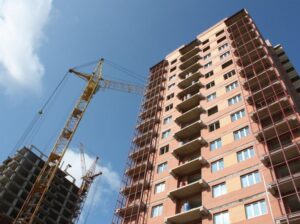The main conditions for construction in adjacent areas in settlements are regulated by the Town Planning and Construction Code of the Republic of Azerbaijan. These conditions are as follows: 1) Distance areas in front of the external walls of buildings should be considered. Construction of surface construction facilities on these areas is not allowed. It is not necessary to maintain the area in front of the external walls within the boundaries of the land plots in the following conditions: • if the construction of the construction object within the boundaries of the land plot is envisaged in the detailed plan (except for the cases when the distance of the existing construction site requires maintenance); • if the construction site is allowed to be built on the boundary of the land plot and the construction of the adjacent land plot on the boundary of the relevant land plot is possible in terms of the requirements of normative documents on urban planning and construction. 2) The distance should be on each plot of land. Intervals are also allowed on roads, public green areas and water areas. In the case of land plots that can be cultivated on both sides, the distances are considered only to the middle of those plots.
3) Intersection of distances is not allowed. This rule does not apply to distances between external walls at an angle of more than 75 degrees to each other. 4) The distance is determined by the height of the wall. The vertical distance from the point of intersection of the wall and the upper surface of the ground to the end of the wall is the height of the wall, and the distance from the surface of the outer wall of the building to the boundary of the land plot. 5) The distance is determined in the following order: • 0.6 part of the wall height; • 0.4 part of the wall height in rural areas and special residential areas (military campuses, student camps, temporary settlements) (0.3 part of the wall height in relation to dwellings to which the notification procedure is applied);
4) The distance is determined by the height of the wall. The vertical distance from the point of intersection of the wall and the upper surface of the ground to the end of the wall is the height of the wall, and the distance from the surface of the outer wall of the building to the boundary of the land plot. 5) The distance is determined in the following order: • 0.6 part of the wall height; • 0.4 part of the wall height in rural areas and special residential areas (military campuses, student camps, temporary settlements) (0.3 part of the wall height in relation to dwellings to which the notification procedure is applied); • 0.25 part of the wall height in areas intended for entrepreneurial activities and industrial areas only. 6) It is not necessary to maintain spacing areas in front of the external walls of buildings or parts of buildings with walls not exceeding 1 meter in height. In addition, it is not necessary to maintain a space in front of buildings or parts of buildings with walls no more than 3 meters high and an area not exceeding 25 square meters and consisting only of garages or adjoining rooms, serving local supply purposes or located in public transport areas.
7) The following should be taken into account when designing a construction object: • maintaining the distances between the external walls and parts of the construction facilities planned to be built on the lands adjacent to the existing buildings, depending on the purpose of the facilities, determined by the normative documents on urban planning and construction; • Possibility to combine facilities in accordance with the project documents for the purpose of efficient use of lands; • Possibility of construction of parallel border facilities on the basis of mutual agreement, taking into account the proposals of the designers, through two parallel and closed (no gaps) walls or a common wall; • Possibility to connect the walls of new facilities to the walls of existing buildings on the border by mutual agreement. How is the placement of facilities in adjacent areas regulated? In built-up and rehabilitated areas, the distance can be reduced taking into account the requirements of normative documents on urban planning and construction. In this case, it is necessary to ensure fire safety, healthy sanitary-epidemiological, insulation and natural lighting conditions of the building. Contrary to these rules, one of the parties may not open window openings or other openings in order to create conditions for insulation and natural lighting.
The following is allowed in the vacant areas (areas) between the objects: • organization of playgrounds and bicycle parking lots; • organization of open terraces with a height not exceeding 50 cm above ground level; • organization of ramps for the disabled; • construction of facilities that do not require a construction permit. Shared walls: • Shared walls must be constructed in accordance with the requirements of urban planning and construction regulations and the needs of both neighbors. • During the restoration work at the construction site, the existing common wall may be demolished and rebuilt in accordance with the project by agreement of the neighbors, or in the absence of such agreement, at the request of one of the parties and by court decision. Adjacent walls: • Any additional building built by one neighbor on a side wall or in a certain part of it at the border may be built by another neighbor only with the notarized consent of that neighbor. In such cases, that part of the wall is considered a common wall.
• If the wall is built parallel to the existing adjacent wall and there is a gap between adjacent walls (the distance between the walls prevents their operation), certain measures should be taken to protect the gap from atmospheric precipitation. Requirements for the construction of fences: • The height of fences should not exceed 2 meters 20 centimeters, except as determined by the relevant executive authority. • When the levels of two adjacent plots are different, the highest level of the plot is taken as the reference point for the height of the fence. • Allow adjacent engineering and communication lines to pass through their area, unless there are other suitable solutions for the construction of utility lines. • During vertical planning of adjacent land plots, appropriate measures should be taken to prevent atmospheric precipitation and irrigation water from flowing from one neighbor’s land to another. Removal of water from atmospheric precipitation through neighboring areas due to the complexity of the terrain is carried out in accordance with the normative documents on urban planning and construction. • Relevant executive authority is a local executive authority, and in the administrative territory of Baku and other cities is the State Committee for Urban Planning and Architecture of the Republic of Azerbaijan. Benefisiar.org




